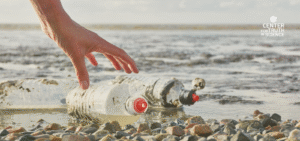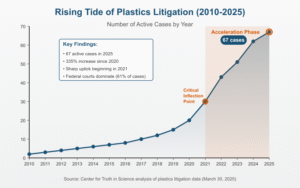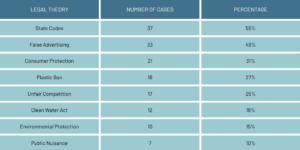
America’s courtrooms have become the new battleground in addressing plastic pollution and its consequences. Our analysis of 67 recent plastics-related cases tracked through the Plastics Litigation Tracker (Plastics Litigation Tracker, 2025) reveals a litigation landscape that is rapidly evolving and increasingly complex. This surge in legal activity raises critical questions about how our society balances scientific evidence, judicial process, and economic realities.
The Acceleration of Plastics Litigation in America
The data is striking: plastics litigation has increased dramatically over the past five years, with a particularly sharp uptick in 2023-2024. Our analysis shows:
- 25 cases with significant updates in 2024 alone
- 5 cases with major developments in 2023
- 5 cases with important decisions in 2022
- Nearly 4 times more active cases compared to 2019-2020

This acceleration comes as scientific understanding of plastic pollution evolves, regulatory frameworks mature, and public awareness intensifies. The litigation surge represents what happens when scientific concerns meet legal mechanisms in the absence of comprehensive policy frameworks.
Note: The Plastics Litigation Tracker, maintained by the State Impact Center and last updated May 23, 2025, tracks cases addressing plastics across federal and state courts, including both resolved and pending cases. Cases can be filtered by category, plaintiff, defendant, and jurisdiction.
Where Are These Cases Being Filed?
Our geographical analysis reveals interesting patterns in where plastics cases are being litigated:
- Federal courts handle 37 cases (55%)
- California state courts are the second most active venue with 15 cases (22%)
- New York follows with 5 cases (7%)
- Other states with cases include Illinois (2), Florida (1), Texas (1), Maryland (1), Connecticut (1), Minnesota (1), and Pennsylvania (1)
The concentration in federal courts reflects the interstate nature of plastic production, distribution, and pollution. California’s prominence aligns with the state’s aggressive regulatory stance on environmental issues and consumer protection.
What Types of Cases Are Being Filed?
The legal theories employed in these cases are diverse, reflecting the multifaceted nature of plastics concerns:

This distribution reveals a notable trend: while traditional environmental claims remain important, consumer-oriented legal theories now dominate the landscape. False advertising and consumer protection claims reflect growing scrutiny of how plastic products are marketed, particularly regarding their environmental attributes and safety profiles.
Who Is Suing Whom?
The parties involved in plastics litigation tell an important story about how responsibility for plastic pollution is being allocated:
- Industry defendants face 41 cases (61%)
- Government entities defend 26 cases (39%)
- Class action plaintiffs bring 20 cases (30%)
- NGOs and individual plaintiffs account for the remaining cases
The predominance of industry defendants suggests that corporations are bearing the primary legal burden for addressing plastic concerns. However, the substantial number of cases against government entities indicates that regulatory bodies are also facing pressure to enhance oversight.
Case Spotlight: California v. PepsiCo (2024)
To understand how these trends manifest in practice, consider one of the most significant recent cases: The People of the State of California v. PepsiCo, Inc., et al., No. 24STCV28450 (Cal. Super. Ct. filed 2024).
This case exemplifies the growing trend of government entities using public nuisance theories to address plastic pollution. California’s Attorney General alleges that major beverage companies created a public nuisance through plastic pollution while making misleading claims about recycling efficacy.
The case is noteworthy for several reasons:
- It targets multiple major corporations simultaneously
- It combines environmental claims with false advertising allegations
- It seeks both injunctive relief and monetary damages
- It represents a state using litigation as a policy tool where legislative approaches have proven insufficient
Like many plastics cases, it raises fundamental questions about who bears responsibility for the lifecycle of plastic products—producers, consumers, or the public sector.
Current Case Outcomes: A Rapidly Evolving Landscape
The resolution patterns in plastics litigation have shifted significantly, with many cases reaching conclusion:
- 54 cases (81%) have been resolved or closed
- 16 cases (24%) remain pending
- Cases with dismissals: 16 (24%)
- Cases with settlements: 12 (18%)
The high rate of case resolution suggests that courts are increasingly willing to rule definitively on plastics-related claims and that parties are finding ways to resolve disputes outside of prolonged litigation.
Notable Case Development: Among the resolved cases, Miller et al. v. Handi-Craft Company Inc., No. 4:24-cv-03782 (N.D. Cal. filed 2024), represents an important example of how litigation around emerging science can evolve. This case involved allegations that plastic baby bottles and sippy cups marketed as “BPA-free” nevertheless leached harmful microplastics when heated, but was voluntarily dismissed by plaintiffs in May 2025 (Miller et al. v. Handi-Craft Company Inc., 2025). The case exemplifies the challenges courts face in evaluating emerging science about microplastics exposure and the translation of scientific uncertainty into legal liability.

Looking Beyond the Numbers
These statistics tell a compelling story about the emerging role of litigation in addressing plastic pollution. However, numbers alone cannot capture the complex dynamics at play.
What’s particularly noteworthy is how these cases reflect shifting societal values around plastics. Courts are increasingly being asked to resolve questions that blend scientific uncertainty, consumer expectations, corporate responsibility, and environmental ethics.
As we’ll explore in the next article in this series, the scientific evidence in these cases presents unique challenges for our judicial system. Courts must evaluate complex and evolving scientific claims about microplastics, chemical leaching, and environmental persistence—often before scientific consensus has fully formed.
What’s Next?
In the coming articles of our series, we’ll delve deeper into:
- Scientific Evidence on Trial: How courts evaluate complex and evolving scientific claims about plastics
- Economic Ripples: The market impacts of plastics litigation on industry, innovation, and consumers
- Beyond Litigation: Policy approaches that might better address plastic concerns than litigation alone
At the Center for Truth in Science, we believe that societal challenges at the intersection of science, justice, and the economy require balanced, evidence-based approaches. The current surge in plastics litigation offers an important case study in how these systems interact—and where they might be improved.
This is the first installment in a four-part series examining the current landscape of plastics litigation in America. The Center for Truth in Science is committed to promoting evidence-based solutions to complex challenges at the intersection of science, justice, and the economy.
Join us for Part 2 of our series Scientific Evidence on Trial: The Challenges of Plastics Litigation.
References
Miller et al. v. Handi-Craft Company Inc., No. 4:24-cv-03782 (N.D. Cal. filed 2024).
Miller et al. v. Handi-Craft Company Inc., Notice of Voluntary Dismissal, No. 4:24-cv-03782 (N.D. Cal. May 20, 2025).
Plastics Litigation Tracker. (2025). State Impact Center. https://plasticslitigationtracker.org/ (accessed May 2025).
The People of the State of California v. PepsiCo, Inc., et al., No. 24STCV28450 (Cal. Super. Ct. filed 2024).